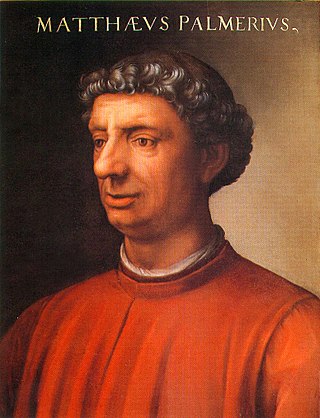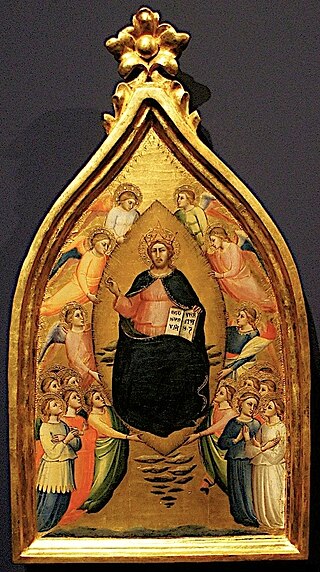
Dante Alighieri, most likely baptized Durante di Alighiero degli Alighieri and widely known and often referred to in English mononymously as Dante was an Italian poet, writer, and philosopher. His Divine Comedy, originally called Comedìa and later christened Divina by Giovanni Boccaccio, is widely considered one of the most important poems of the Middle Ages and the greatest literary work in the Italian language.

Andrea del Castagno or Andrea di Bartolo di Bargilla was an Italian Renaissance painter in Florence, influenced chiefly by Masaccio and Giotto di Bondone. His works include frescoes in Sant'Apollonia in Florence and the painted equestrian monument of Niccolò da Tolentino (1456) in Florence Cathedral. He in turn influenced the Ferrarese school of Cosmè Tura, Francesco del Cossa and Ercole de' Roberti.

The Battle of Montaperti was fought on 4 September 1260 between Florence and Siena in Tuscany as part of the conflict between the Guelphs and Ghibellines. The Florentines were routed. It was the bloodiest battle fought in Medieval Italy, with more than 10,000 fatalities. An act of treachery during the battle is recorded by Dante Alighieri in the Inferno section of the Divine Comedy.

The Certosa di Pavia is a monastery complex in Lombardy, Northern Italy, situated near a small village of the same name in the Province of Pavia, 8 km (5.0 mi) north of Pavia. Built from 1396 to 1495, it was once located at the end of the Visconti Park a large hunting park and pleasure ground belonging to the Visconti dukes of Milan, of which today only scattered parts remain. It is one of the largest monasteries in Italy.

Filippo Villani was a chronicler of Florence. Son of the chronicler Matteo Villani, he extended the original Nuova Cronica of his uncle Giovanni Villani down to 1364.
Certosa is an Italian word meaning Carthusian monastery, or charterhouse. It may refer to:

Gavorrano is a mountain-side comune (municipality) in the Province of Grosseto in the western Italian region of Tuscany, located about 100 km (62 mi) southwest of Florence and about 25 km (16 mi) northwest of Grosseto. Gavorrano borders the municipalities of Castiglione della Pescaia, Grosseto, Massa Marittima, Roccastrada and Scarlino.
The International School of Florence (ISF) is one of the oldest international schools in Europe. It is located in Florence, Italy, and was formerly known as the American International School of Florence. The ISF is an independent, coeducational, and nonsectarian institution. The school is fully accredited with the Council of International Schools (CIS) and the Middle States Association of Colleges and Schools (MSACS).

Florence Charterhouse is a charterhouse, or Carthusian monastery, located in the Florence suburb of Galluzzo, in central Italy. The building is a walled complex located on Monte Acuto, at the point of confluence of the Ema and Greve rivers.

Matteo di Marco Palmieri (1406–1475) was a Florentine humanist and historian who is best known for his work Della vita civile which advocated civic humanism, and his influence in refining the Tuscan vernacular to the same level as Latin. He was sent as Florentine ambassador to the court of Alfonso I of Naples. Vespasiano da Bisticci included him among the illustrious men of his generation whose careers deserved an article in his Vite di uomini illustri del secolo XVvita.

Corso Donati was a politician and leader of the Black Guelph faction in 13th- and early 14th- century Florence.
Gualdrada Berti dei Ravignani was a member of the Ghibelline nobility of twelfth-century Florence, Italy. A descendant of the Ravignani family and daughter of the powerful Bellincione Berti, Gualdrada later married into the Conti Guido family. Her character as a pure and virtuous Florentine woman is called upon by many late medieval Italian authors, including Dante Alighieri, Giovanni Boccaccio, and Giovanni Villani.
Piccarda Donati was a medieval noblewoman and a religious woman from Florence, Italy. She appears as a character in Dante Alighieri's Divine Comedy.

Niccolò Acciaioli or Acciaiuoli was an Italian noble, a member of the Florentine banking family of the Acciaioli. He was the grand seneschal of the Kingdom of Naples and count of Melfi, Malta, and Gozo in the mid-fourteenth century. He was the son of Acciaiolo, a wealthy Florentine merchant. He had a sister by the name of Andrea Acciaioli.

Mariotto di Nardo di Cione was a Florentine painter in the Florentine Gothic style. He worked at the Duomo of Florence, the church of Santa Maria Maggiore, and the Orsanmichele. He created both frescoes and panel paintings, and was also active as a manuscript illuminator.

The Villa di Mondeggi is a villa located south to Florence (Italy), on the territories of the cities of Bagno a Ripoli, Impruneta and Greve in Chianti. Since 2014, the arable land, olive groves and some of the buildings are occupied by a group reclaiming the land to be managed in accordance with the principles of the commons,.

The Villa Carducci-Pandolfini is a historic rural palace located on Via Guardavia, on the road between Legnaia and Soffiano. It is located in the town limits of Legnaia. The property is now part of Polo Museale of Tuscany, and open only by appointment.

Guido Guerra V (1220-1272) was a politician from Florence, Italy. Aligned with the Guelph faction, Guerra had a prominent role in the political conflicts of mid-thirteenth century Tuscany. He was admired by Dante Alighieri, who granted him honor in the Divine Comedy, even though he placed Guerra in Hell among sinners of sodomy.

Palazzo Acciaiuoli, also known as Palazzo Usimbardi' or Usimbardi-Acciaiuoli, is located in Borgo Santi Apostoli in the historical centre of Florence. It incorporates the older Torre degli Acciaiuoli, formerly dei Buondelmonti, located at the corner of Chiasso delle Misure. Today it houses a hotel.

















